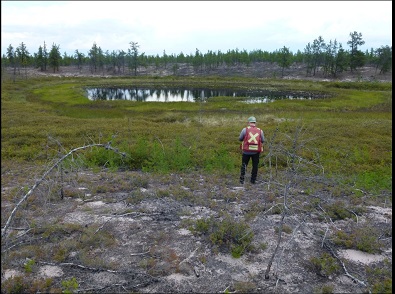View of pond with distinct circular structure that corresponds to magnetic anomaly detected by Government airborne survey and confirmed by De Beers’ surveys. Photo courtesy CanAlaska.
Helicopters have been flying over northwest Saskatchewan’s Athabasca Basin for the past two months, in what’s being called an “aggressive” first step in De Beers’ diamond exploration.
De Beers kicked off its seven-year exploration agreement with CanAlaska Uranium in June, in which De Beers can earn in to the West Athabasca Diamond Project by carrying out a series of work programs.
The airborne surveys in the western Athabasca have given the company a more detailed picture of potential kimberlite fields, with geologists zoning in on 75 different magnetic surface anomalies. Kimberlite is the type of rock that hosts diamonds.
“We now have indications from the survey of a large kimberlite field in the western Athabasca,” CanAlaska President Peter Dasler said in a statement.
The De Beers team on the ground has been based out of Fond du Lac. In addition to the overhead surveys, they’ve been collecting rocks and sand to send to laboratories to look for clues that the rock in the area is kimberlite, said De Beers Canada’s head of external and corporate affairs Tom Ormsby. So far they’ve collected over 100 of those samples.
“We know there are other minerals and things that are generally created and transported in the same way as diamonds are, so we look for those clues,” Ormsby said.
The quest to verify that there are, in fact, kimberlite formations in the CanAlaska stakes in the 17,400-hectares of the Athabasca Basin, is heading into the next phase of exploration. De Beers is currently forming a plan to dig into the rock formations that seem most promising and are accessible at this time of year.
The decision to start a drilling program by September, Ormsby said, is related to some promising early assessments. It’s also related to weather.
“This one was certainly a big priority for us because it was a large area to cover, and it was new area and we try to find out as much information as we can as quickly as possible because we work in remote access areas and the seasons are not long, with fall being a difficult season to get work done,” Ormsby said.
The goal here is to actually strike kimberlite rock and hopefully find more than one kimberlite formation, he said. The drilling program will continue in the winter of 2017, as the majority of formations are underwater and inaccessible at this time.
The drill core will be studied at De Beers’ facilities.
The amount of activity that follows will depend less on seasons and more on money, Ormsby said.
Each new phase in De Beers’ four-phase, seven-year optioning agreement with CanAlaska will require significantly more funding. Thus, results need to be promising enough to drive the next level of investment.

A CanAlaska Uranium graph shows the level of investment De Beers must put in to earn certain percentages in the West Athabasca Diamond Project.
